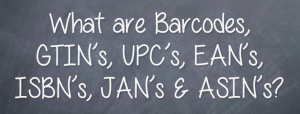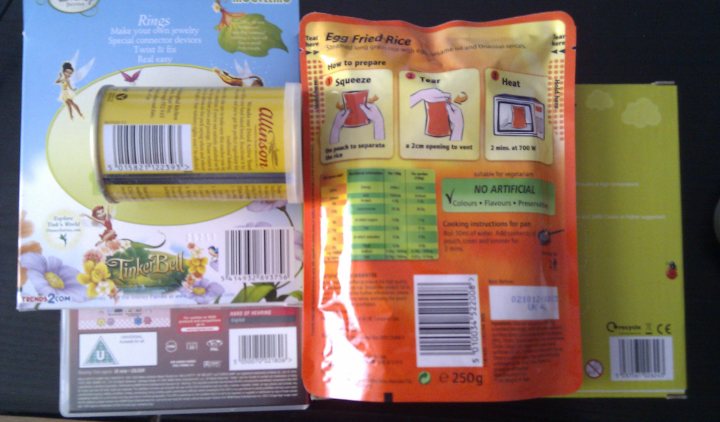Barcodes, GTIN’s,UPC’s, EAN’s, ISBN’s, JAN’s & ASIN’s Explained
 Barcodes, these can cause confusion, especially if we account for all the different names they can be referenced as and even the term barcode isn’t technically correct, GTIN is. As such this article aims to dis-spell the myths & confusion around them and give you the 101 on the different variations, what they are and how they’re used.
Barcodes, these can cause confusion, especially if we account for all the different names they can be referenced as and even the term barcode isn’t technically correct, GTIN is. As such this article aims to dis-spell the myths & confusion around them and give you the 101 on the different variations, what they are and how they’re used.
For the purpose of this article, I’m going to broadly call all GTIN (Global Trade Item Numbers) as ‘barcodes’, this is what you’ll likely to recognise them as from day-to-day items and will help keep things in plain English (which I know you like).
What is a “Barcode”?
A ‘barcode’ is the visual representation of a set of numbers. In the video below, I show several products and on the back of each of them are images and some numbers, like in the image below:
 The ‘barcode’ is the vertical lines and these are the visual form of the numbers below, ie 012345678900. However for ease, very few people know what GTINs are and the term “barcode” will make more sense to more people as we’ve all seen them on products, like soup. So I’m calling them ‘barcodes’.
The ‘barcode’ is the vertical lines and these are the visual form of the numbers below, ie 012345678900. However for ease, very few people know what GTINs are and the term “barcode” will make more sense to more people as we’ve all seen them on products, like soup. So I’m calling them ‘barcodes’.
A barcode by its correct name is a GTIN or its full name ‘Global Trade Item Number’. These come in various forms and are globally universal indentifies to find product information across databases and differing platforms.
Think of them as an international “postcode” that identifies a single address, but for products.
Video Explaining Barcodes with Examples
This video covers the contents of this article, including examples and where you can obtain your own barcode range for selling on eBay & Amazon.
Note: Before you watch the video, I’m going to quickly add that this was recorded last year, since then I’ve solved the lighting and sound quality issues, plus my office has been re-decorated with the artwork from the children.
Why are Barcodes Important?
When you’re shopping (say in Tesco’s) you’ll see the clerk scan the items through the till, the till is scanning the barcode on the product and then this is being looked up in a database to obtain its price and do some other stuff too.
Barcodes are ‘keys’, this is a term for used in databases and the idea is just like your front door key, the key should only fit one lock, thus that key belongs to that door and ‘ideally’ none others (see the note on this later).
This is why when your items are being scanned in the supermarket, the price is returned and you gain an accurate bill. Also in the background, this key is also used for many other purposes, such as stock control and reporting functions.
In short, one barcode = one product
Barcodes on Amazon
Just like in the supermarket when shopping, Amazon also uses these ‘barcodes’ as unique identifiers for products.
There are some exceptions which are for seeds & plants, furniture and home decoration categories and in such instances approval must be gained from Amazon to do this. However as a general rule you will need a barcode to create a new product on Amazon.
Note: While barcodes used for Amazon should be unique, it’s possible to find products on Amazon that have more than one GTIN used to identify a product. This is caused by two reasons:
- Expiry
As I cover in the video above, barcodes are leased, not owned. It’s quite possible for the barcodes to be re-used and thus two different products have the same barcode identifier for them. - Duplication bySellers
It’s quite common for two different businesses to have their own barcode ranges, as such with unbranded goods its quite possible for the same product (say a pair of boots) to be listed more than once on Amazon under different identifiers.
GTIN Variations
There are five main types of GTIN’s that are in use (with regards to Amazon), these are:
- ISBN
- UPC
- EAN
- JAN
- GTN-14
ISBN’s
 These you’ll find on books, this is because ISBN is short for ‘International Standard Book Number’ and can come in both 13 and 10 digit numbers.
These you’ll find on books, this is because ISBN is short for ‘International Standard Book Number’ and can come in both 13 and 10 digit numbers.
I’ve included a photo of the back of one of the books I’m reading at the moment and you’ll see in the bottom right-hand corner an ISBN both as a number and the visual representation of that number for barcode readers.
UPC’s
These are “Universal Product Code’s” and generally you’ll find them on most USA (American) based items.
The use of these in the UK for products is somewhat limited and you’ll see EAN’s far more more often and you’ll see why in the next section.
EAN’s
EAN is short for ‘European Article Number’, hence this why you’ll see these more frequently in the UK.
EAN’s are everywhere, some examples are below on some random items I found in my home, if you look around your’s, you’ll find they’re everywhere!

JAN’s
These are ‘Japanese Article Number’s and, to be honest, you’re unlikely to come across them in the UK for products listings to Amazon or just about anywhere.
GTIN’s
Global Trade Item Number or GTIN’s have a few names, the first is GTIN-14, UCC14 or ITF-14, ultimately they are 14 digits.
ASIN’s
![]() An ASIN is an acronym for ‘Amazon Standard Identification Number’. Once an inventory record has been created on Amazon, Amazon assigns their own version of a barcode, called the ‘ASIN’ and it’s a key that is unique to the Amazon marketplace.
An ASIN is an acronym for ‘Amazon Standard Identification Number’. Once an inventory record has been created on Amazon, Amazon assigns their own version of a barcode, called the ‘ASIN’ and it’s a key that is unique to the Amazon marketplace.
The crucial note here is that ASIN’s are Amazon’s own product identification system and is unique to Amazon.
Note: I am working on a more in-depth description of what ASIN’s are, it’ll be published in the next week or so, if I forget to update this article (quite likely) search for ASIN at the top of this site.
Obtaining a Barcodes
Barcodes are not technically owned by a business owner, instead they are leased for a period of time. You can lease these from numerous companies, however, the source of these is a company called GS1, you can find more information about them here http://www.gs1.org/barcodes or http://www.gs1uk.org/ for the United Kingdom.
Allocation is based upon the companies requirement, for example if you are a small manufacturing firm with only a few products, then you may only be allocated 1000, however if you require hundreds of thousands, then you’ll be allocated many, many more.
The fees for the subscription are based upon company turnover, using the current figures (July 2011) from the UK GS1 site, the joining fee is £107 and the annual company annual subscription fee is £117.
You can contact GS1 at http://www.gs1uk.org/about-us/Pages/Contact-Us.aspx if you have any specific questions regarding pricing and subscriptions.
Summary
Barcodes or should I now say GTIN’s are everywhere and they are a way for businesses to assigned unique product identifiers to their products.
They appear in several common formats and we should also note that while a ASIN is not a true GTIN, its so commonly used in eCommerce for Amazon, it might as well be.
So do you feel more comfortable with ‘barcodes’ now, how and where they’re used? Let me know in the comments box below & if you have any feedback, I’d also love to hear from you.

